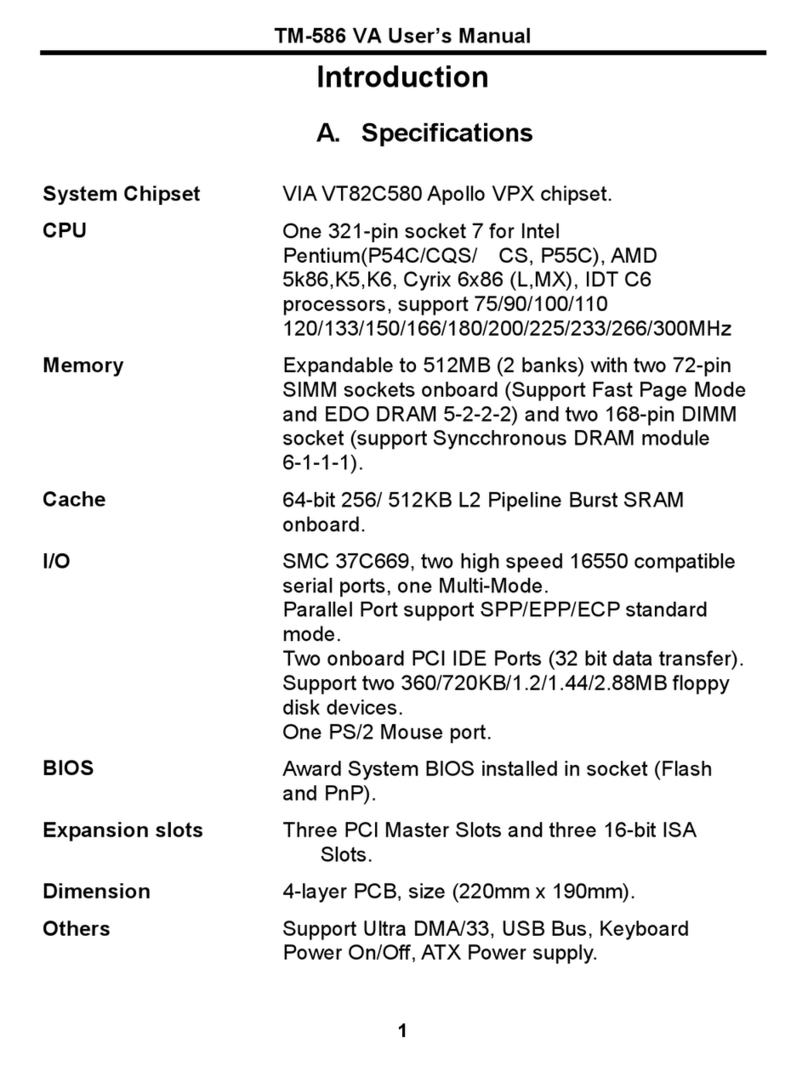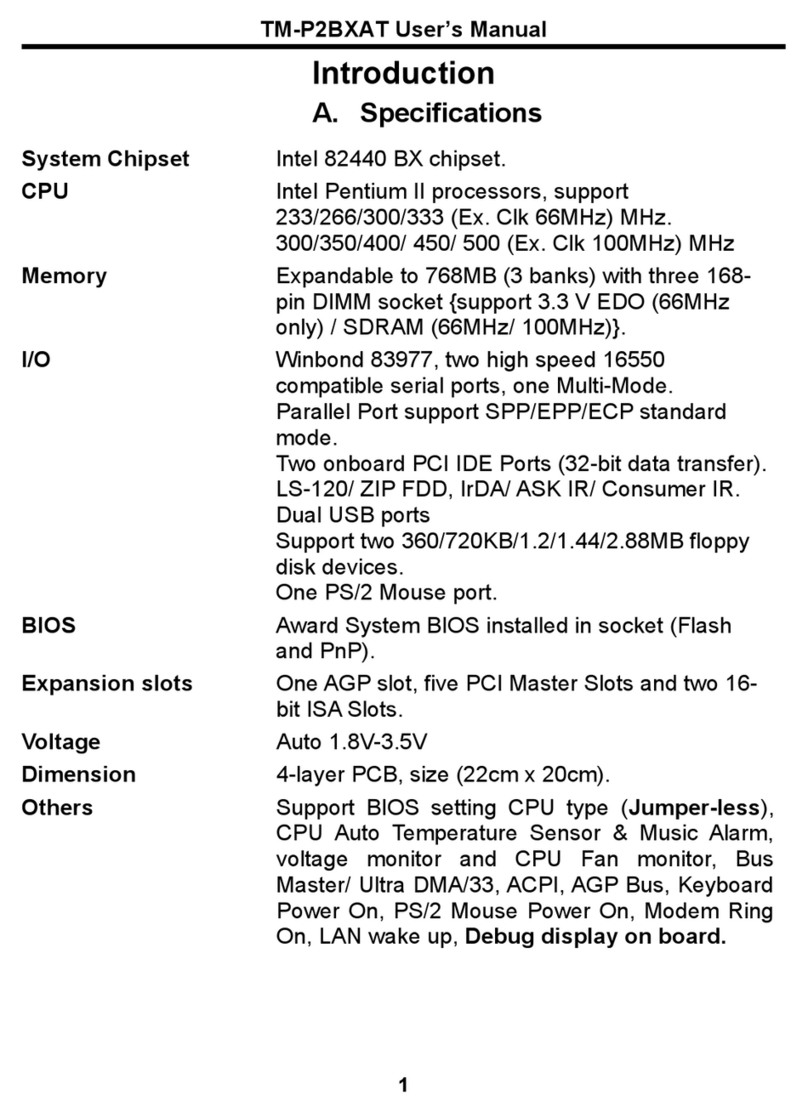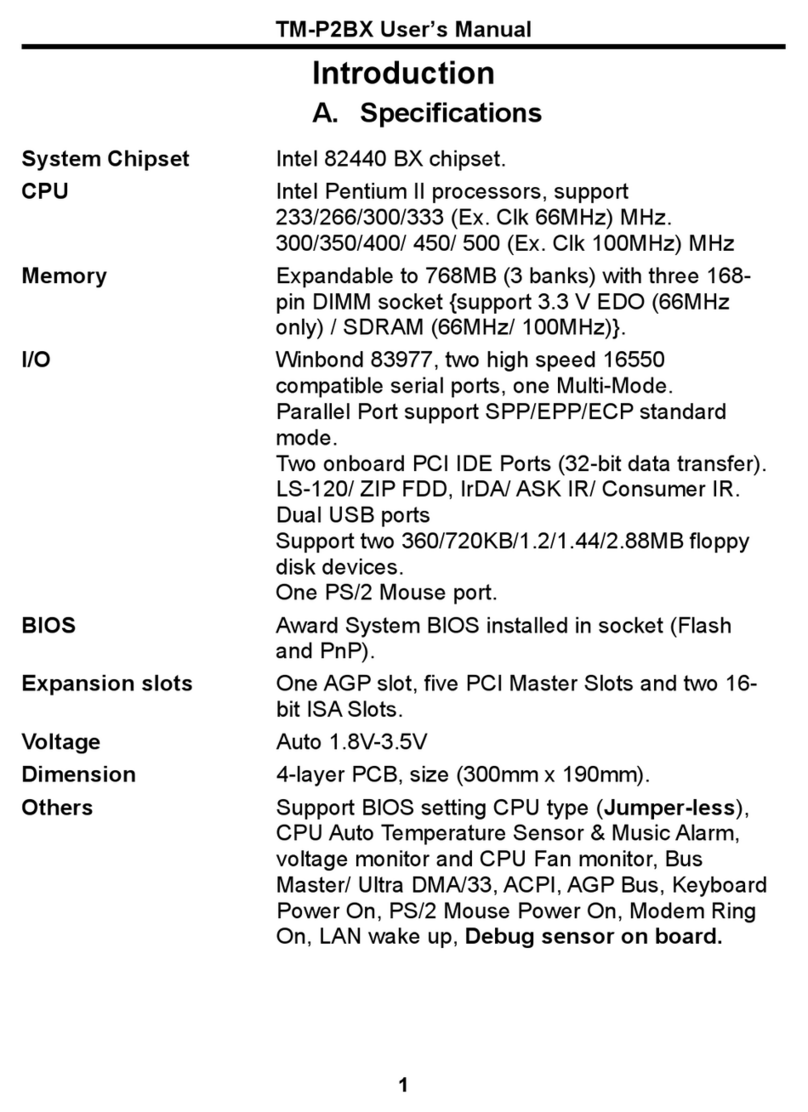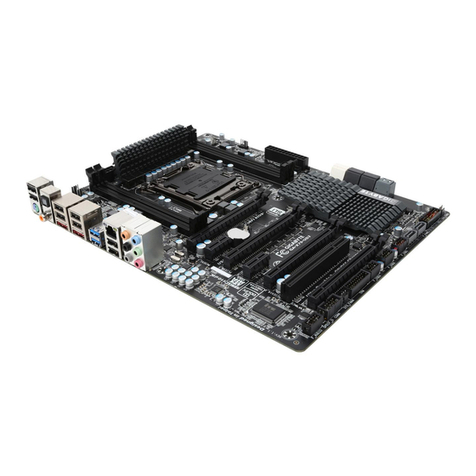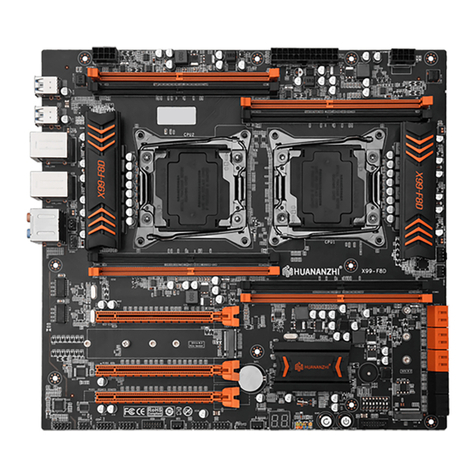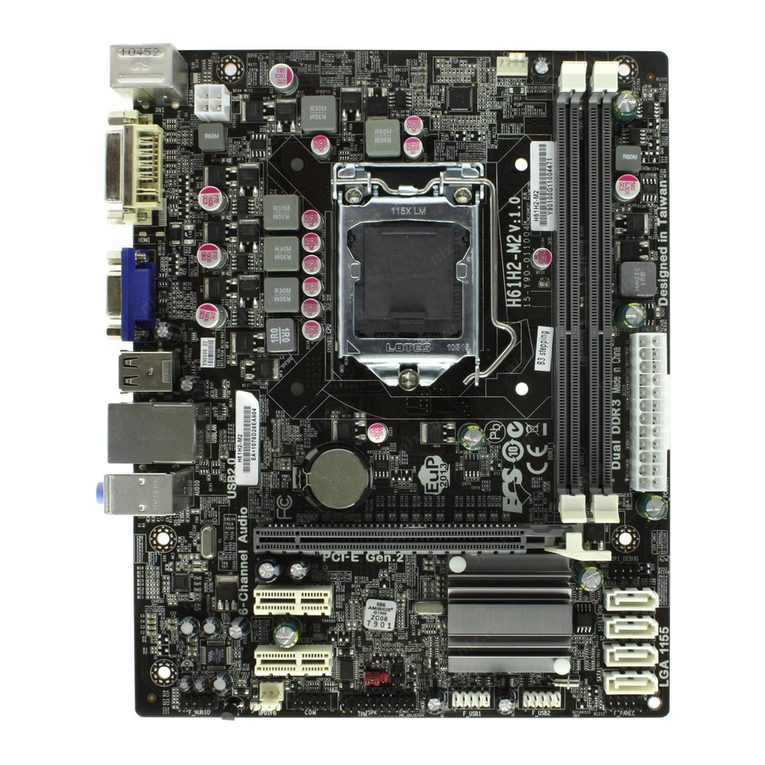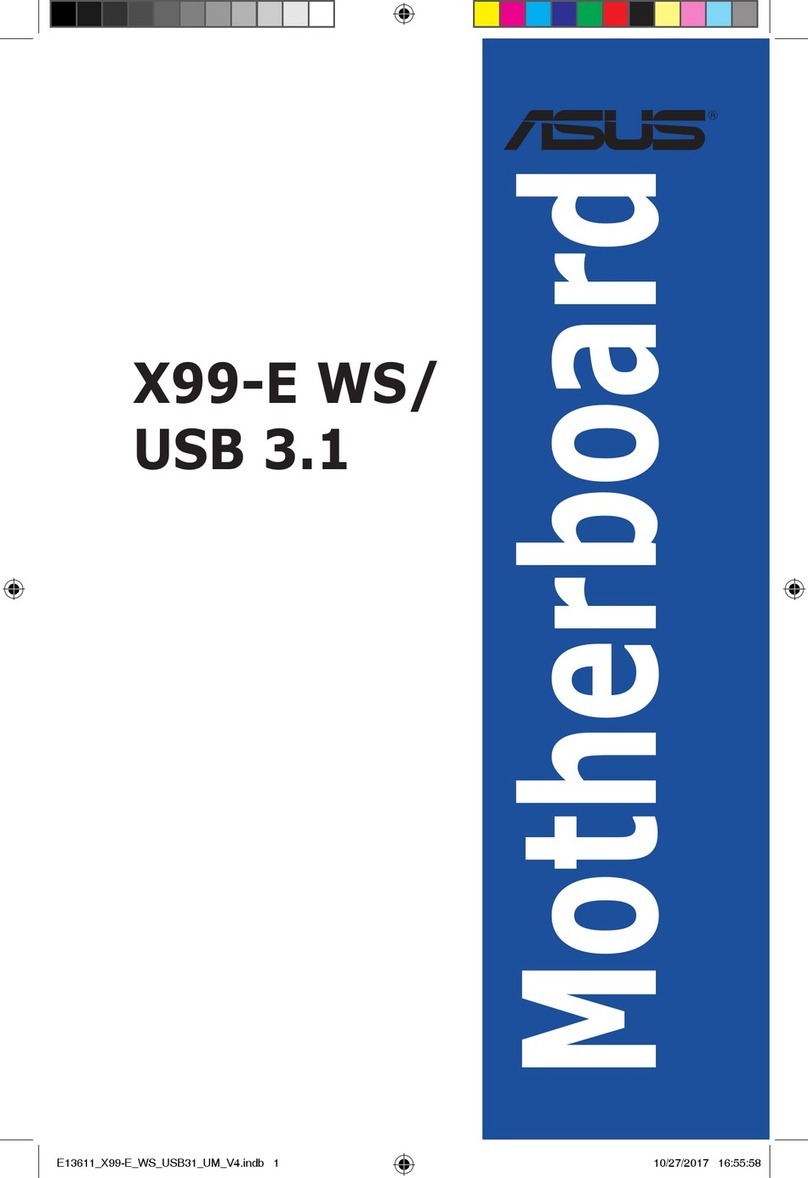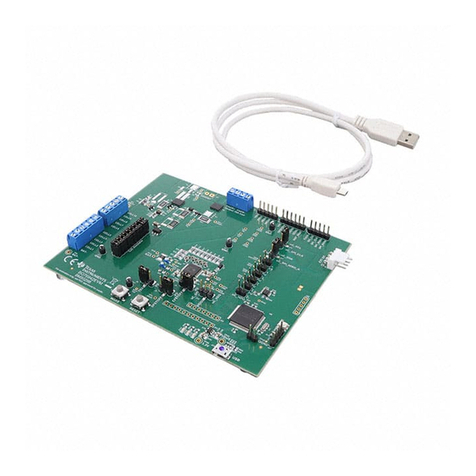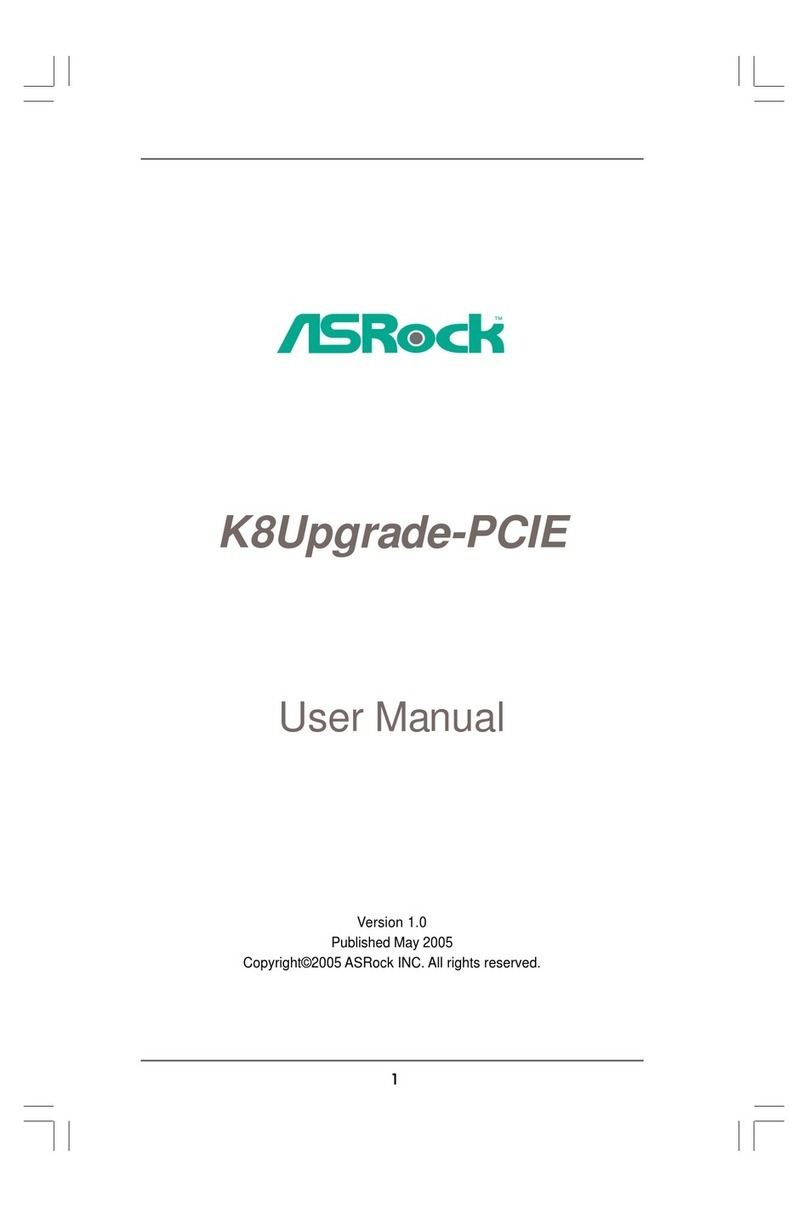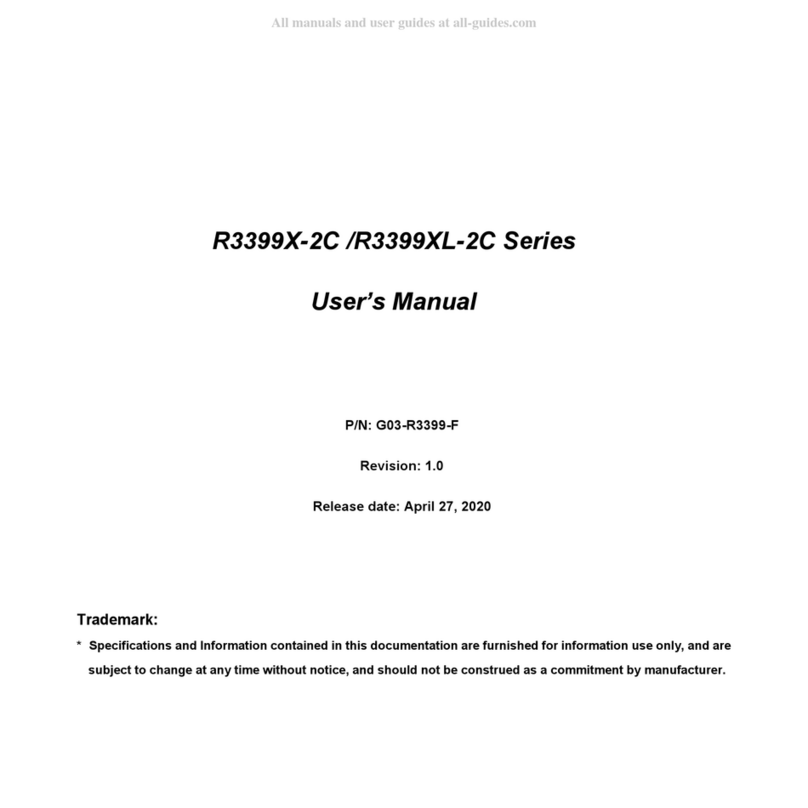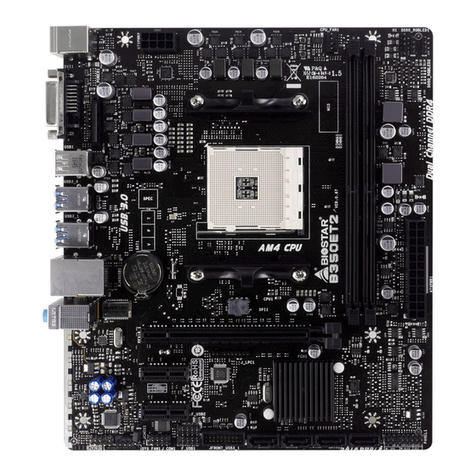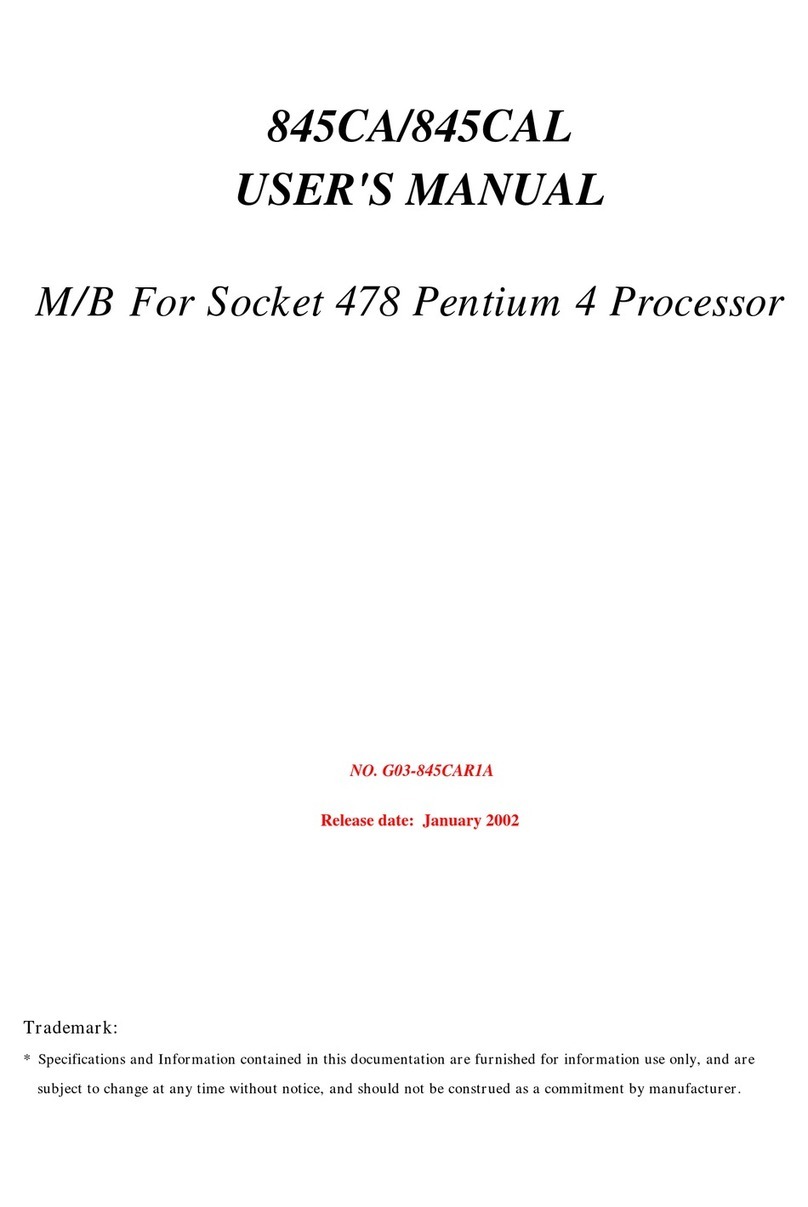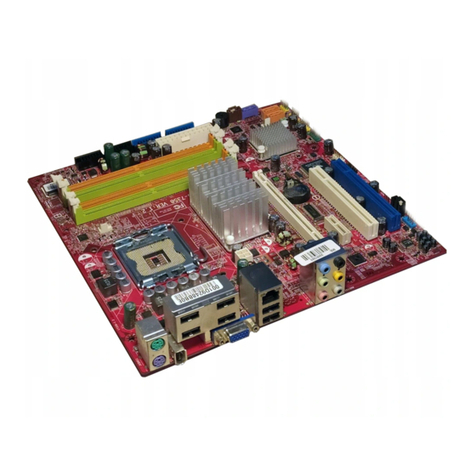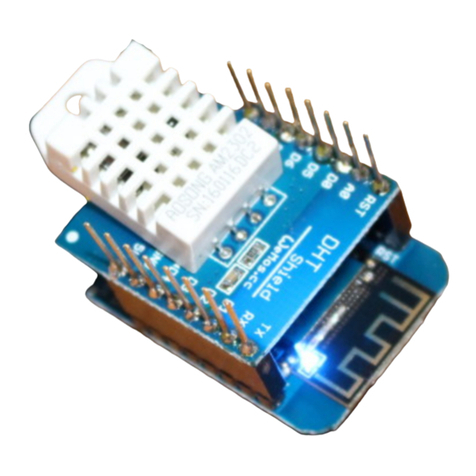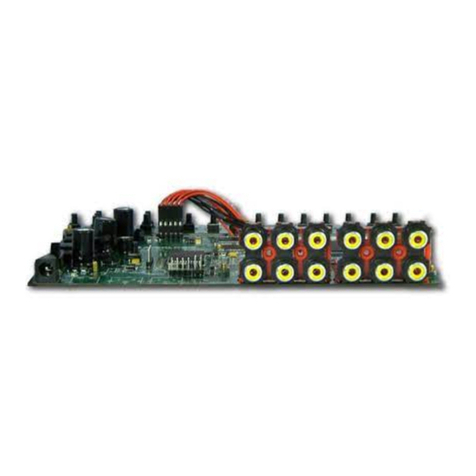Totem TM-P2LX User manual

TM-P2LX User’s Manual
Introduction
A. Specifications
System C ipset Intel 82440 LX chipset.
CPU Intel Pentium II processors, support
233/266/300/333/366 MHz.
Memory E pandable to 384MB (3 banks) with three 168-
pin DIMM socket (support 3.3 V SDRAM RAM).
I/O Winbond 83977, two high speed 16550
compatible serial ports, one Multi-Mode.
Parallel Port support SPP/EPP/ECP standard
mode.
Two onboard PCI IDE Ports (32 bit data transfer).
LS-120/ ZIP FDD, IrDA/ ASK IR/ Consumer IR.
Dual USB ports
Support two 360/720KB/1.2/1.44/2.88MB floppy
disk devices.
One PS/2 Mouse port.
BIOS Award System BIOS installed in socket (Flash
and PnP).
Expansion slots One AGP slot, four PCI Master Slots and three
16-bit ISA Slots.
Voltage Auto 1.8V-3.5V
Dimension 4-layer PCB, size (300mm 190mm).
Ot ers Support BIOS setting CPU type (Jumper-less),
CPU Auto Temperature Sensor & Music Alarm,
voltage monitor and CPU Fan monitor , Bus
Master/ Ultra DMA/33, ACPI, AGP Bus, Keyboard
Power On, PS/2 Mouse Power On, Modem Ring
On.
1

TM-P2LX User’s Manual
Setup Guide
A. Layout Diagram
2

TM-P2LX User’s Manual
B. Note to Installing t e Mainboard
Touch the non-coated area on the computer case or use a grounded wire to
release static electricity before you open the anti-static electricity bag and
take out the mainboard. It's likely to damage the mainboard components
while taking out the board without first releasing static electricity. During
installation, avoid touching the components on the mainboard.
C. CPU Voltage and Frequencies
ROM PCI/ISA BIOS (2A69JTJ9)
CHIPSET FEATURE SETUP
AWARD SOFTWARE, INC
Auto Configuration : Enabled CPU Speed : Manual
DRAM Speed Selection : 60ns CPU Ratio : X 3.5
MA Wait State : Slow CPU Frequency : 66 MHz
EDO RAS# To CAS# Delay : 3 Auto Detect DIMM/ PCI Clk : Enabled
EDO RAS# Precharge Time : 3 Spread Spectrum : Disabled
EDO DRAM Read Burst : 333 CP Warning Temperature : Disabled
EDO Dram Write Burst : 222 Current CPU Temperature : 28℃/ 82℉
CPU-To-PCI IDE Posting : Enabled Current SYSFAN Speed :4285 RPM
System BIOS Cacheable : Enabled Current CPUFAN Speed :4000 RPM
Video BIOS Cacheable : Enabled Current Vin3 (V) : 2.88V
Video RAM Cacheable : Disabled
8 Bit I/O Recovery Time : 1
16 Bit I/O Recovery Time : 1
Memory Hole At 15M-16M : Disabled
Passive Release : Enabled Esc : Quit Selection : Item
Delayed Transaction : Disabled F1 : Help PU/PD/+/- : Modify
AGP Aperture Size (MB)
SDRAM RAS-to CAS Delay
SDRAM RAS Precharge
Time
SDRAM CAS latency Time
: 64
: Fast
: Fast
: 3
F5 : Old Values (Shift) F2 : Color
F6 : Load BIOS Default
F7 : Load Setup Default
Dear Customers:
Thank you for your patronage of our products. The board you bought is a
jumper-less mainboard. The ratio and frequency of the CPU shall be set in
BIOS and the working voltage for the CPU shall be automatically detected.
Please read carefully the following instructions:
1. Power on the installed system and press the "DEL" key to enter BIOS
Setup. Select "Chipset Features Setup" and press <Enter>.
3

TM-P2LX User’s Manual
2. Select "CPU Speed" and press "PgUp" or "PgDn" to set the CPU ratio and
frequency. The available options are: Intel PII 233MHz (66X3.5), 266MHz
(66X4), 300MHz (66X4.5), 333MHz (66X5), 366MHz (66X5.5) and "Manual".
To set the CPU manually, please note the following:
CPU Speed: "Manual" (you can manually set the CPU ratio and frequency)
CPU Ratios: 3.5, 4, 4.5, 5, 5.5
CPU Frequency: 50MHz, 60MHz, 66MHz, 68MHz, 75MHz, 83MHz
Several options are provided for the CPU e ternal clock. You are
recommended to restore to the default setting in case of instability when the
e ternal clock e ceeds 66MHz.
NOTE: System failure may occur if the CPU frequency is set incorrectly. To
solve this problem. Press the "Insert" key on the keyboard to clear the
previously set frequency (i. c., restore the default frequency), and then
reboot the system.
Switch voltage is applied, making the temperature lower and voltage
steadier.
You don’t need to adjust Voltage in Pentium II mainboard. It will
automatically send out one VID (Voltage Identification) to the mainboard
power supply to ask for the voltage it needs.
The CPU type default setting is Intel Pentium II 266MHz=66 MHz*4.
Intel Pentium II CP family
CPU E t. clk Ratio L1 cache L2 cache Package
Intel Pentium II – 450MHz 100MHz X4.5 32KB 512KB SECC 1
Intel Pentium II – 400MHz 100MHz X4 32KB 512KB SECC 1
Intel Pentium II – 350MHz 100MHz X3.5 32KB 512KB SECC 1/ 2
Intel Pentium II – 300MHz 100MHz X3 32KB 512KB SECC 1
Intel Pentium II – 333MHz 66MHz X5 32KB 512KB SECC 1
Intel Pentium II – 300MHz 66MHz X4.5 32KB 512KB SECC 1
Intel Pentium II – 266MHz 66MHz X4 32KB 512KB SECC 1
Intel Pentium II – 233MHz 66MHz X3.5 32KB 512KB SECC 1
4

TM-P2LX User’s Manual
D. EDO/ SDRAM Installation Procedures:
A 168-pin DIMM can support up to 384MB 3.3V EDO/ SDRAM.
Default setting: 3.3V. (Only)
To avoid compatibility and reliability problems, you are recommended to
test the 168-pin SDRAMs before buying them since the PCB
specifications differ.
First, verify the working voltage of the EDO/ SDRAM module in either
DIMM socket.
P2LX only supports 3.3V EDO/ SDRAM module. The following
illustration shows you the difference between 3.3V and 5V to ensure
your correct selection of 3.3V DIMM module for using.
You can set up the BIOS “Chipset Feature Setup” to the best working
condition basing on the type of EDO/ SDRAM you are using.
The BIOS DRAM default setting is 60 ns. Change the BIOS “Chipset
Feature Setup” default setting to 50ns for better performance, if the
chipset is marked 50ns.
5

TM-P2LX User’s Manual
Change nothing if EDO RAM is used. BIOS automatically detects the
RAM type.
MEMO for Installing System:
⊕ Concerning memory setup, you can find how to from “C ipset
Feature Setup” under BIOS setup. However, to avoid system unstable
or system hang, user without engineering background is not suggested
to change BIOS set up.
⊕ If system boot failure, please clean DIMM socket (wit clean oil) or
polish Gold-Finger of DRAM with soft eraser, and try again.
The Dual Inline Memory Module (DIMM) must be 3.3 Volt and
Unbuffered Synchronous DRAM (SDRAM) 8MB, 16MB, 32MB or 64MB.
The following illustration shows the type of DIMM Module.
168-PIN SDRAM DIMM Notc Key Definitions
6

TM-P2LX User’s Manual
E. Ot er Jumper Settings
Speaker:
Connect to the system’s speaker for beeping.
Keylock:
Keyboard lock switch and Power LED connector.
Reset:
Short to restart system.
HDD LED:
LED ON when on board PCI IDE hard disk activates.
POWER SW (FOR ATX POWER SUPPLY):
The button should be a momentary switch that is normally open.
Pushing the ATX Power Switch will immediately change the system
status. Before or during “POST”, you need to hold the button for four
seconds in order to turn off the system.
J19: Clear CMOS
7

TM-P2LX User’s Manual
Turn off the system and short pins 2-3 to clear CMOS. Then short pins
1-2 before turning it on.
J19
1-2 Normal operation(Default).
2-3 for clearing CMOS Data.
CPU Cooler Fan connector
This is the connector for CPU cooler. Never use the jumper to short the
connector. Serious damages caused this way will not be warrantied.
F. Note to BIOS Update
Do not update the BIOS if no abnormalities occur. However, if BIOS
update is needed, consult your dealer first. Prior to updating your BIOS,
you are recommended to save the original BIOS values.
1. Download the AWARD BIOS Flash Utility file (Awdflas .exe)
2. Download the BIOS file used by your mainboard (e.g.,
LXV110N.BIN)
3. Reboot your system (but do not run Himem.sys and Emm386.exe)
to
e ecute the new BIOS program.
4. E ecute these commands: Awdflas LXV110N.BIN
5. When this message displays: "Do you want to save BIOS (Y/N)?"
Type "N"
6. When this message displays: "Are you sure to program (Y/N)?"
Type "Y"
7. Turn off power to your system to clear the CMOS data.
8. Turn on the power to test if your system is running normal.
8

TM-P2LX User’s Manual
G. Keyboard/ PS/2 Mouse Power On and MODEM Ring on
To make sure t e 5VSB signal nearly to 750mA (Amperage) from
ATX Power Supply, or if your keyboard consuming power t an
300mA, it's better to upgrade your ATX Power Supply to 1A for
working perfectly.
If you are going to use the function of keyboard and PS/2 mouse power on,
then, the power-switch will be becoming useless automatically (unable to be
used).
ROM PC/ISA BIOS
INTEGRATED PERIPHERALS
AWARD SOFTWARE, INC.
IDE HDD Block Mode : Enabled Onboard Serial Port 2 : 2F8H / IRQ3
IDE Primary Master PIO : AUTO UART Mode Select : Normal
IDE Primary Slave PIO : AUTO
IDE Secondary Master PIO : AUTO Onboard Parallel Port : 378H/IRQ 7
IDE Secondary Slave PIO : AUTO Parallel Port Mode : ECP+EPP
IDE Primary Master UDMA : AUTO ECP Mode Use DMA : 3
IDE Primary Slave UDMA : AUTO EPP Mode Select : EPP 1.9
IDE Secondary Master
UDMA
: AUTO
IDE Secondary Slave UDMA : AUTO
On-Chip Primary PCI IDE : Enabled
On-Chip Secondary PCI IDE : Enabled
USB Keyboard Support : Disabled
Init AGP Display First : Enabled
POWER ON Function : Hot KEY
Esc : Quit Selection : Item
Hot Key Power ON : Ctrl-F12 F1 : Help P /PD/+/- : Modify
KBC input clock : 8MHz F5 : Old Values (Shift)F2 : Color
Onboard FDC Controller : Enabled F6 : Load BIOS Default
Onboard Serial Port 1 : 3F8H / IRQ4 F7 : Load Setup Default
Hot KEY When user select this option, it will show another line
lines as Hot Key Power ON: Ctrl-
F(1/2/3/4/5/6/7/8/9/10/11/12) select any you like. After
power off, if user key in the "Ctrl-F?", it will power on the
system.
PS/2 Mouse Left It will power on the system by PS/2 mouse left.
9

TM-P2LX User’s Manual
PS/2 Mouse Right It will power on the system by PS/2 mouse Right.
Button Only Only the power button can power on the system.
Modem Ring On Function Operation:
ROM PCI / ISA BIOS (2A69JTJ9)
POWER MANAGEMENT SETUP
AWARD SOFTWARE, INC
Power Management : Disabled ** Reload Global Timer Events **
PM Control by APM : No IRQ[3-7, 9-15], NMI : Enabled
Video Off Method : V/H SYNC+Blank Primary IDE 0 : Disabled
Video Off After : Standby Primary IDE 1 : Disabled
MODEM Use IRQ : 3 Secondary IDE 0 : Disabled
Doze Mode : Disabled Secondary IDE 1 : Disabled
Standby Mode : Disabled Floppy Disk : Disabled
Suspend Mode : Disabled Serial Port : Enabled
HDD Power Down : Disabled Parallel Port : Disabled
Throttle Duty Cycle : 62.5%
ZZ Active in Suspend : Disabled
VGA Active Monitor : Enabled
Soft-Off by PWR-BTTN : Instant-Off
CPUFAN Off In Suspend : Enabled
Resume by Ring : Enabled
IRQ 8 Clock Event : Disabled Esc : Quit Selection Item
F1 : Help PU/PD/+/- : Modify
F5 : Old Values (Shift) F2 : Color
F6 : Load BIOS Default
F7 : Load Setup Default
1. Have an e ternal MODEM connected to COM 1 or COM 2.
2. Enter BIOS setup.
3. Select Power Management Setup.
4. T is number of MODEM use IRQ as to be set as same as t e IRQ of
Serial Port w ic you are connecting in. Please set in N/A if you are
not going to use t e function of MODEM ring on.
5. Resume by Ring: Enable.
6. Save BIOS setup and Reboot.
7. Booting from DOS, Windows, or Windows 95.
8. Turn off the system by:
a. ATX-Power Switch
b. Windows 95 Software Power Off
9. System Waiting for Modem Ring On
10

TM-P2LX User’s Manual
When Modem Ringing Signal Active, System will wake-up.
H. System Healt Monitor
Fan Monitoring:
There are two fan connectors, one is for CPU, the other can be a
housing fan. When the fans speed is working abnormal, there will be
warning (Speaker Alarm) through application software such as
SM10(Small Icon for System Monitoring) to notify user. The fan
monitoring function is implemented by connecting fan to 3-pin fan
connector FAN1/ FAN2 and installing SM10. Referring to Page 11
(System Health Monitor).
CPU T ermal Protection:
11

TM-P2LX User’s Manual
TM-P2LX implements special thermal protection circuits. When
temperature is higher than a predefined value, there will be warning
(Speaker Alarm) through application software such as SM10 (Small
Icon for System Monitor) to notify user. It's automatically implemented
by BIOS or SMD10, no hardware installation is needed. Referring to
Page11 (System Health Monitor).
This mainboard also reserves an option to use special CPU cooling
Fan. With T ermal Sensor on it. The CPU thermal sensor should be
connected to J16.
System Voltage Monitoring:
TM-P2LX is featured with a voltage monitoring system. When you turn
on your system, this smart design will keep on monitoring your system
working voltage. If any of voltage is over the component's standard,
there will be Speaker Alarm though application software SM10 (Small
Icon for System Monitor) for a warning to user. System voltage
monitoring function monitors 5V, 12V, 3.3V and CPU voltage. It's
automatically implemented by BIOS and SM10, no hardware installation
is needed. Referring to Page 11 (System Health Monitor).
12
Table of contents
Other Totem Motherboard manuals
